Turn your content into cash with 8 proven monetization strategies
As of 2023, creators in the US were already earning up to $100,000 annually. The earning potential is even bigger today, with regular people everywhere reaching celebrity status using just their smartphones, the internet, and some creativity.
Our point? There’s never been more money flowing through the creator economy, and now is a better time than any to secure your piece of the pie.
So, whether you’re a newbie or someone who’s been creating consistently without much financial reward, this content monetization guide is for you. It covers:
- The kinds of content you can monetize, even without viral posts or millions of followers
- How to start your monetization journey, plus 8 specific strategies for earning
- Why self-hosting is your best defence against algorithm fluctuations
What is content monetization?
Content monetization is the process of making money from your online content, whether it’s educational, entertaining, or use-driven. It lets you create what you want from any platform or location and earn from that creativity.
Since online content reaches audiences worldwide, people and brands anywhere can pay you for products, services, sponsorships, or collaborations. In-platform earnings, such as YouTube ad revenue or TikTok gifts, are also great content-driven income streams.
What kind of content can you monetize?
The most profitable formats tend to fall into one or more of these categories:
| Educational content | Entertaining content | Utility-driven content |
|---|---|---|
| Knowledge you can pass down or skills you can teach E.g., courses, workshops, and communities. | Relatable and engaging content that acts as the start of a funnel or earns through views E.g., memes, videos, posts, skits, and vlogs. | Resources people pay for to simplify their lives or save time. E.g., templates, quizzes, or guides. |
Simple content monetization
These take less time and are typically low-hanging fruit.
- Social media videos: Short-form videos like Reels, Shorts, and TikToks are booming. Longer videos, like on YouTube, also still have their place. Earn from them through subscriptions, brand deals, course teasers, and built-in monetization tools like Instagram Bonuses and YouTube ads.
- AI-generated content: If your AI content is valuable and policy-compliant, you can monetize it through one-time sales or subscriptions. Most platforms emphasize originality, transparency, authenticity, and clear labelling in their AI monetization policies, so stay updated. Also, use AI to support, not replace, your unique voice. For example, short self-help ebooks or digital art.
- Podcasts: With enough loyal listeners in a specific audience group, your podcast can attract sponsorships, paid subscriptions, and ads. Platforms like Apple Podcasts and Spotify also offer paid subscriber features for early access or bonus content.
More advanced content monetization
These take a bit of time and resources to create, but the payoff (hello recurring revenue!) is usually worth it. You can sell them to multiple people simultaneously and repurpose them as many times as possible.
- Courses: Earn passively while positioning yourself as a subject matter expert. Create and sell courses as standalone offerings or make them part of a paid community.
- Live events: Earn in real time via paid live sessions like Q&As, workshops, coaching sessions, or casual “build in public” streams. You can also make the event free and monetize through gifts (e.g., YouTube Super Chats, Facebook Stars, and TikTok Gifts).
- Templates, swipe files, or resource libraries: These assets, such as content calendars or AI prompt lists, are high-value, low-effort digital products. They save your audience time and work well as lead magnets, marketplace products, premium membership perks, or paid newsletter content.
How to start monetizing your content—in 5 steps
We won’t be the ones to tell you that building a profitable creator business is easy.
But anyone with a little hustle, determination, and an eye on the big picture can get started in five steps.
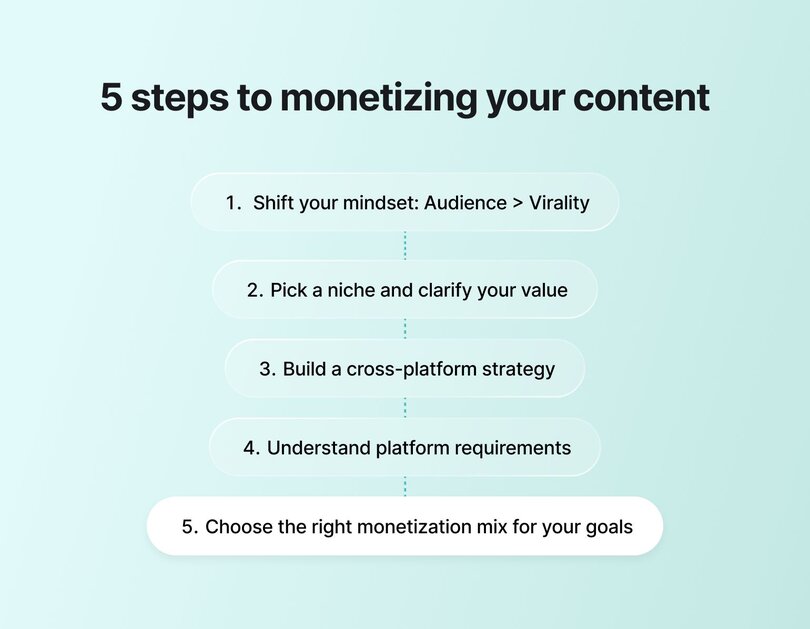
1. Change your mindset
It’s easy to get caught up in going viral—it's the new “life-changing moment” of our society.
But to build something that perseveres, focus on building an audience, not just chasing views.
This mindset shift keeps you creating consistently, even before the recognition and earnings roll in. Remember: you’re building a community, not chasing a one-hit wonder.
2. Choose a niche and value proposition
Trying to be everything to everyone stretches you thin and dilutes your impact.
Instead, pick a niche, clarify your value, and define the problems you solve and transformations you help facilitate. This exercise helps set clear content pillars, reduce burnout, and build trust with your audience, making selling a natural next step.
3. Create a cross-platform content strategy
Posting the same piece of content on every channel is so 2016: tailor and repurpose content to each platform’s vibe instead.
A strong cross-platform content strategy prevents frustration from creating too many low-return assets and ensures audience reach across multiple touchpoints. For example, you can use YouTube for deep dives, Instagram for social proof and humor, TikTok for transformational snippets, and email newsletters for conversions.
4. Consider the eligibility requirements for platform monetization
Major platforms like YouTube, Instagram, and Facebook offer built-in monetization tools, but you must first meet specific requirements. The table below breaks them down, though some vary by region and account type.
| Platform | Eligibility requirements | Income sources | AI-generated content monetization policy |
|---|---|---|---|
| YouTube monetization | Must have: 1,000+ subscribers with 4,000+ valid public watch hours in the last 12 months OR 10 million valid public Shorts views in the last 90 days | Watch page ads, Shorts feed ads, memberships, Supers, and YouTube shopping | Allowed, but must be disclosed so Gen AI labels can be added to the description or the video itself |
| Instagram monetization | Must: Be 18 years or older Have a professional account with 10,000+ followers Comply with monetization policies and community guidelines | Badges, subscriptions, bonuses, branded content, profile ads, gifts, and affiliate product tagging | Allowed if transparent, human-reviewed, and compliant with Meta’s guidelines |
| Facebook monetization | Must: Be 18 years or older Set account to professional mode Maintain an established presence for at least 30 days Meet content and monetization guidelines | Ads on Reels, in-stream ads, subscriptions, Stars, paid online events, and brand collabs | Same as Instagram: Allowed if high-quality and policy-compliant |
5. Understand the different monetization mechanics
Monetization doesn’t look the same for all content creators. Your content type, audience size, and niche all have a role to play. Here are the most common models:
✅ Subscriptions
Let followers or fans pay monthly for exclusive content (e.g., via a Circle community), whether through a VIP/gated newsletter, or a community membership. Subscriptions are great for creators with a solid community and high-value knowledge.
✅ One-time purchases
From selling ebooks to courses, templates, coaching sessions, merch, and presets, one-time purchases could be the key to your burgeoning online empire. This approach works best when your content solves specific problems and generates enough trust to convert prospects.
✅ Affiliate revenue
Earn commission from promoting other brands’ products and services. Affiliate marketing is ideal for folks working in niches like coaching, freelancing/contracting, tech, SaaS, fashion, fitness, parenting, and personal finance. Why? Because for subjects like these, many people depend on recommendations and word of mouth to make decisions.
The opportunities for affiliate commissions online are massive, and they look different depending on your industry:
- Your favourite writing expert promoting a business partner’s design services launch
- A fashion influencer’s LTK page
- An Instagram account that shares great Amazon deals through its affiliate links
- Community strategists promoting the tools they rely on
✅ Brand partnerships
Partner with companies to create sponsored content. Collaborations are ideal for creators with a loyal, niche audience, no matter how small. Micro-influencers can still make bank here, especially with user-generated content (UGC) styles.
8 proven content monetization strategies
Monetizing your content effectively and consistently takes time and strategic planning. Here are eight proven content monetization strategies you can explore.
1. Paid memberships & communities
Paid memberships and communities—with the right pricing strategy—work well if you’ve built a loyal following. No matter how few or many, these are your brand advocates: people who want deeper access and would happily tell others good things about you.
Take Dave Gerhardt, founder of Exit Five, for example. He started by sharing B2B marketing insights on LinkedIn. Once interest grew, he moved to a gated model using Patreon and a free Facebook Group.
This setup was okay in the beginning, but it began to feel clunky after a while. His search for a better alternative led him to Circle Plus, which he used to build a branded mobile app for his +6,000-member community.
The result? A unified space for Exit Five’s content and community, increased engagement, and the brand’s first million-dollar year.

Tips to monetize a membership
- Focus on growing your audience. Create consistent, high-value content, build real relationships, and prioritize depth over fluff. Distribute smartly through collaborations, repurposing, and social sharing—for a solid community-led growth strategy.
- Price with intention. Base your pricing on your income goals, industry benchmarks, perceived member value, and your positioning. You can start free, offer a free trial, or test payment tiers as traction grows.
- Iterate and get expert help. Refine your offer, format, or pricing as you learn what works. When in doubt, lean on experienced community consultants to save time and avoid costly mistakes.
| Pros | Cons |
|---|---|
| Stronger connection with superfans | Platform fees or setup costs |
| Community-led growth (referrals and word-of-mouth) | Requires ongoing content and community engagement |
2. Online courses & digital products
As a subject matter expert, selling courses and digital products, like templates and toolkits, is a great way to turn your knowledge into revenue. These assets require minimal ongoing effort once live, and they can easily serve as a natural entry point into your paid community.
Anne-Laure Le Cunff is a neuroscientist and founder of Ness Labs, a mindful productivity school for knowledge workers. She has built a global audience through cohort-based mindful productivity courses.
Priced at $49/year, the brand’s private community has 2,000 members, many of those attracted by perks like discounted productivity tool subscriptions and unlimited course access. Some key Ness Labs courses include a mindful productivity masterclass, a short Roam Research guide, and an idea bank building roadmap.
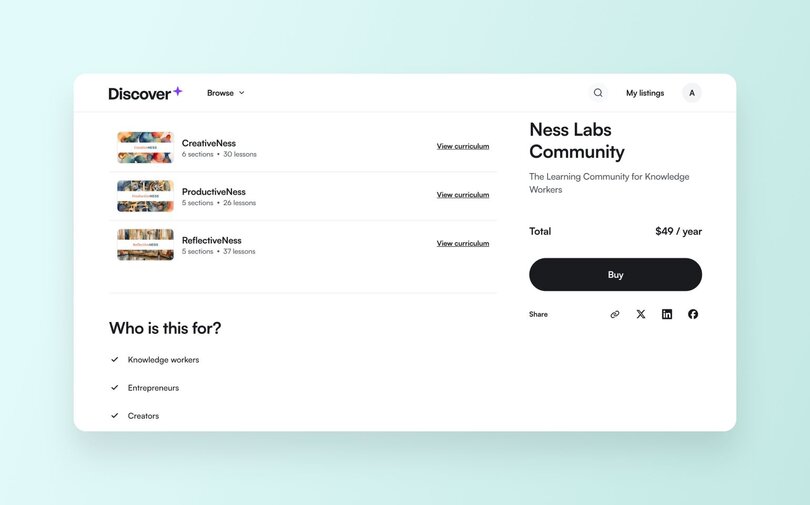
Tips for monetizing courses and products
- Start small: Ensure your first course or digital product solves a clear, recurring problem for your audience. Subsequent products can be more complex or experimental.
- Choose a format that matches your strengths: Not a fan of video? Go with templates or quizzes. Don’t have the time to write a book? Create video crash courses instead. If you have the resources to outsource, get someone to fill in where your weaknesses are (like podcast or video editing, or design, etc.).
- Use your product as a membership gateway: Once someone buys your course or template, invite them to join your (paid) community for ongoing support, conversations, or exclusive updates. Or, position your community as more valuable by promoting course access as a membership benefit.
| Pros | Cons |
|---|---|
| Evergreen content that can be promoted more than once | Requires upfront effort to build and market |
| Establishes you as a subject matter expert | May need updates over time |
3. Live events & workshops
Live events and workshops—including webinars, summits, or AMAs—create urgency, offer real-time value, and deepen audience relationships. Many brands also gate live sessions within paid communities or course programs, while others share previews of past events or host standalone ones (free or paid) as a pathway to membership.
Seasoned entrepreneur Pat Flynn runs Smart Passive Income (SPI), a brand focused on helping individuals grow their business to full-time and more. He hosts occasional free workshops that accommodate non-members and many premium virtual events for SPI community members only.
For example, once you land on Pat’s site, you’ll see a webinar pop-up, which he uses as a lead magnet. He also has a dedicated events page for both open-to-all and member-only programs.
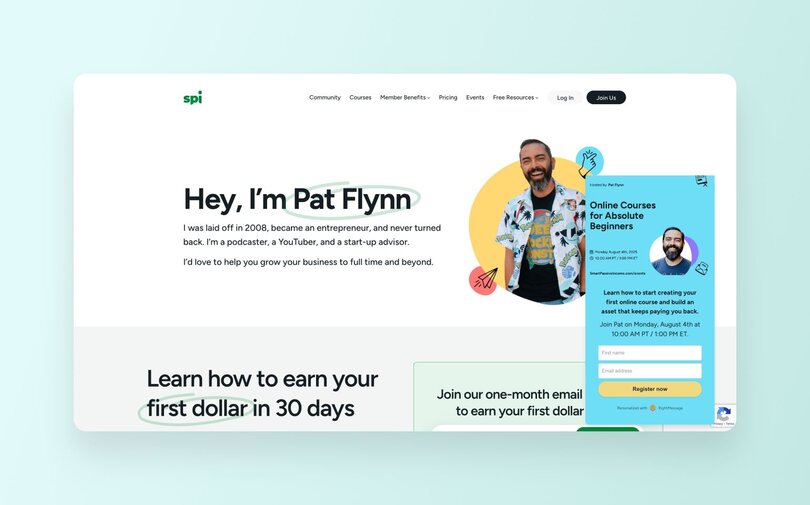
Tips to get started with paid live events
- Pick a bite-sized topic that signals urgency or transformation. Highlight timely pain points or specific outcomes people want, e.g., “Launch Your First Digital Product in 10 Days” or “LinkedIn for Busy CEOs”.
- Use events as a conversation starter. Live sessions can help build trust with your target audience. So after each event, ask attendees to join your community for more resources and networking.
- Repurpose often. Extend the value of your live session recordings with minimal effort by turning them into replays, mini-courses, or extra content for your paid community members.
| Pros | Cons |
|---|---|
| Builds trust and drives engagement | Requires scheduling and promotion |
| Converts well into community or product offers | May need practice or paid speakers to deliver effectively |
4. Affiliate marketing & sponsorships
Once followers trust you, affiliate marketing and sponsorships can be low-effort, high-reward ways to add to your revenue streams. Earn from recommending tools and services you already use and love—or by partnering with brands that are relevant to your niche.
Jay Clouse, founder of Creator Science and The Lab community, earns affiliate income by recommending tools he uses, like Circle and Notion. His detailed breakdowns and honest content build trust, and he attracts brand deals via an open sponsor call on his site.
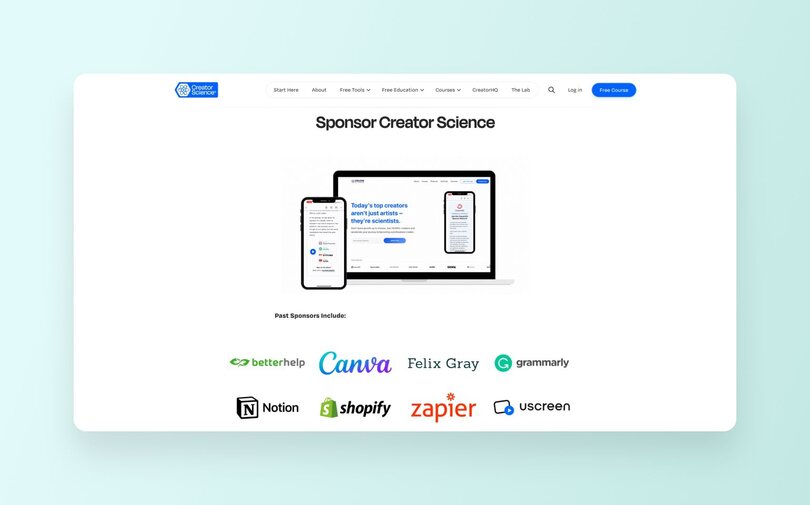
Tips to get started with affiliate marketing
- Vet brands beforehand: Use, reach out to, and deeply research products before recommending them. Authenticity drives conversions—and protects your credibility.
- Weave affiliate links and brand mentions into valuable content 😉: Don’t just drop links. Show how the product fits into your workflow or solves real audience pain points.
- Pitch aligned prospects: Collaborations won’t always fall into your lap, especially at first. Offer member perks, event partnerships, or newsletter placements—so you can earn without cluttering your content.
| Pros | Cons |
|---|---|
| Stacks well with other monetization models | Delayed or commission-based payouts |
| Scales with audience size and engagement | Can dilute your brand if misaligned or excessive |
5. YouTube monetization
The second-largest social network globally, YouTube gives your content a longer shelf life and high search discovery potential. So, if you enjoy being on camera (or don’t mind outsourcing it), you can earn YouTube dollars through ads, premium viewers, brand deals, and features like Super Thanks, among others.
Productivity Lab founder Ali Abdaal started his YouTube journey in 2017. Since then, his channel has garnered millions of subscribers. And, he monetizes through ads, brand collabs, channel memberships, and more.
Tips to get started with YouTube monetization
- Play the long game: Plan content around keywords and topics your audience is searching for. And check out our YouTube playbook for more tips.
- Start with what you have: You don’t need fancy gear or the perfect setup to start. Clear messaging, valuable content, and a likable on-screen presence go further than perfect lighting or editing.
- Project your potential earnings: YouTube monetization varies by niche, geography, and engagement. Estimate your YouTube earnings and plan accordingly.
| Pros | Cons |
|---|---|
| Multiple monetization streams in one place | Monetization thresholds can take time to reach |
| Evergreen content with passive income potential | Quality video production can be time and resource-intensive |
6. Instagram/Facebook/TikTok monetization tools
Platforms like Instagram, Facebook, and TikTok have built-in tools for monetizing short-form video and visual content, from Reels bonuses to subscriptions. These tools benefit consistent creators and are often entry-level ways to start earning from content you’re already posting. Brand collabs and sponsored posts also come into play here.
For instance, you can get content monetization on Facebook through in-stream ads, Reels bonuses, subscriptions, or Stars (Facebook’s version of tips). To qualify, your account typically needs to meet Meta’s Partner Monetization Policies and engagement thresholds, like having an established presence for at least 30 days.
Over the years, Glo Atanmo, a content creator and co-founder of Life Leap Network, has leveraged Instagram’s paid partnerships feature to execute brand deals with companies like Avana, Mixtiles, and Delta. She also earned a whopping $400,000 from her Social Educators Academy, which she promoted largely on Instagram in 2022.
What’s more? She has now launched a podcast and begun taking TikTok seriously—both of which are strategic content monetization bets.
Tips to get started with monetizing social presence
- Check in-app monetization eligibility: On Instagram or Facebook, go to your professional dashboard and navigate to monetization tools to see available features and requirements. For TikTok, switch to a Creator or Business account, then visit the creator center and open the monetization tab to check eligibility for the creator fund, series, or LIVE gifts. You can also get a general idea of in-app monetization eligibility requirements in the table shared above.
- Hop on the short-form content train: Use Reels, TikToks, and Stories to spark interest and drive engagement, then invite people to view your longer content or subscribe to your other (paid) channels.
- Post consistently: Regular, on-brand content builds long-term trust and opens doors to subscriptions, bonuses, brand deals, and predictable earnings.
| Pros | Cons |
|---|---|
| Excellent reach and discovery for short-form content | Platform policies and payouts can change anytime |
| Complements paid products and services | Income can be inconsistent |
7. Physical products
Physical items—like merch, books, consumables, or limited-run brand collabs—can become additional income streams beyond digital products. They’re powerful ways to express creativity, reward loyalty, and offer a new access point into your ecosystem. They can also serve as thank-you gifts or bundled incentives.
Modern Fertility is a company that focuses on sharing reproductive health advice online and generating revenue through the sale of at-home hormone tests, ovulation kits, and specific medications. The brand also runs a private virtual community for support discussions and more resources, illustrating how physical products can complement digital community experiences.
Clearly doing a thing or two (or three!) right, Modern Fertility was acquired by healthcare startup Ro for $225 million in 2021—and has been growing strong ever since.
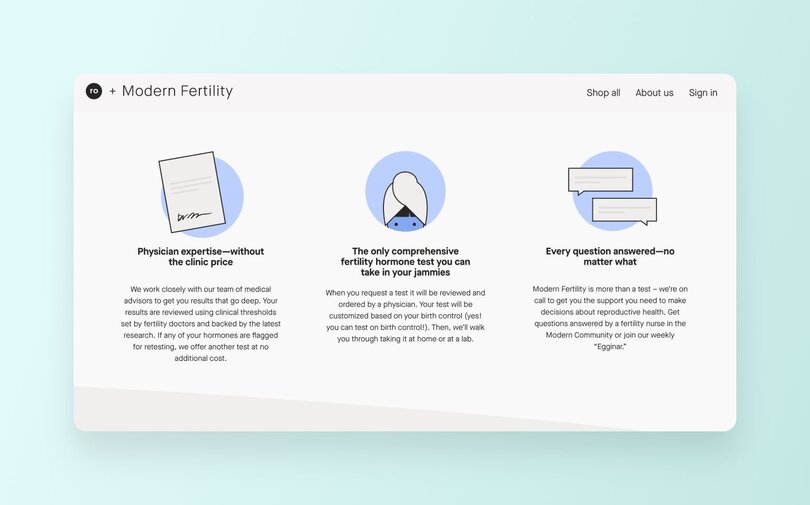
Tips to get started with physical products
- Focus on audience-aligned products: Gauge audience interest through polls or pre-orders, from t-shirts with your catchphrases or artwork to productivity tools like journals or vision boards.
- Don’t over-invest: Use small-batch or print-on-demand suppliers to test the waters with minimal expenses. Even if you see early traction, err on the side of caution till demand is high and predictable.
- Combine with other offers: Bundle merch or other physical products with community or events, like welcome gift bags for new members or signed copies with membership coupons at in-person workshops.
| Pros | Cons |
|---|---|
| Boosts brand visibility and emotional connection | Inventory, shipping, or quality control can get tricky and time-consuming |
| Tangible connection with your brand | Lower margins and more logistics compared to digital products |
8. Hybrid models
Most content monetization models work best when you layer both passive and active earning, because it allows you to test different models to see what works best for your business. Combining multiple income streams, like free content leading to paid communities or low-cost lead magnets funnelling into a premium newsletter, also reduces your risk if one source fails.
Anna Tyrie of The Conversation Club (English Like a Native) shares free resources—like grammar PDFs and level tests, and guides—on her social media accounts. She then uses them as funnels into her paid courses (one-time payments of between $99 and $399) and membership community ($29/month and $79/quarter).
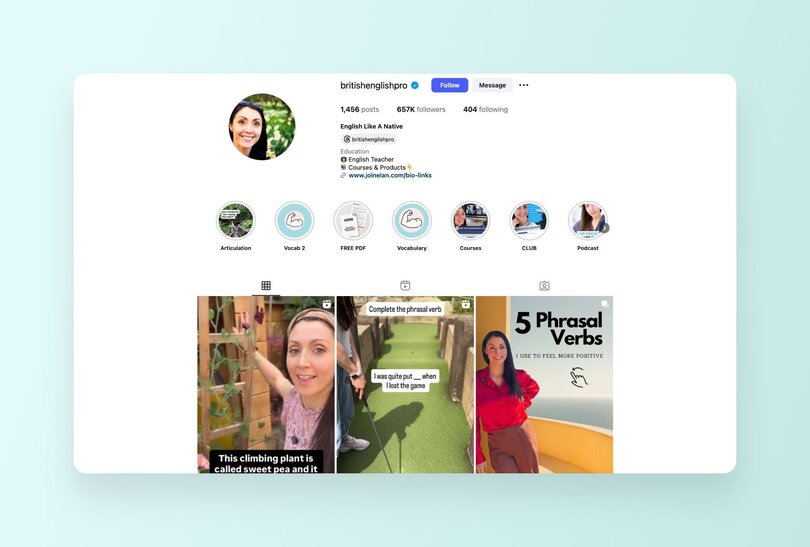
Note: Many of the earlier examples also operate hybrid monetization models in various forms.
Tips to get started with different revenue streams
- Map out your free-to-paid funnels: Plan how free content (like public posts and downloadable templates) can naturally lead to higher-value offerings like paid courses, memberships, or events.
- Tweak existing content: Leverage your free content to tease paid offerings. Edit old blog articles, social media posts, and downloads to include premium offer mentions and CTAs.
- Reiterate continuously: Constantly review how your different revenue streams work together and double down on content that resonates most with your audience and drives better conversions.
| Pros | Cons |
|---|---|
| Flexible and adaptable to creators of all types | Maintaining multiple content types or platforms can be challenging |
| Maximizes income potential | Requires a strategic approach to ensure each income stream supports the others |
Platform dependency vs. platform ownership
The downside of relying on social media platforms with changing algorithms for your income is instability and burnout. What works today may not work tomorrow. TikTok may get banned. Payment terms might change. And if you’re ill-prepared, you’ll be left scrambling.
Here's a perfect example of how social platforms can hang you out to dry.
Enter owned platforms—channels that are completely yours.
Why owning your platform = sustainable revenue
Owning your platform (and having direct access to your audience) ensures income you control, and builds a business in a sustainable, reliable way for the long term. You control your content and pricing, and can keep tabs on your audience, without the unpredictability of algorithms or fear of losing your account unexpectedly.
Community platforms like Circle help you do just that:
| Platform dependency | Platform ownership |
|---|---|
| Reliance on 3rd-party platforms like social media or marketplaces to stay in touch with and monetize your audience | Having your own platform, like a website, email list, community, or branded mobile app, where you control the content, user data, and customer relationship |
| Vulnerability to platform changes, account bans, or algorithm updates | Platform management and content monetization with minimal external restrictions |
| Monetization options largely depend on platform rules and features | Freedom to create your own monetization strategies, custom-designed for your audience |
How Circle helps you monetize your content (and your brain)
Circle lets you bundle all your revenue streams—tiered memberships, private communities, gated content, courses—under one roof. This flexibility makes it easy to manage and scale your earnings without relying on external platforms.
Take a look at what our customers have to say:
💰 “We’ve made over $3 million on Circle over the last two years… This is the power of a true ‘all-in-one’ platform.”
— Tiago Forte, Founder of Forte Labs
🔗 “I love having everything in one spot (Circle). My lead magnets, products, membership, conferences…everything!”
— Katie Orr of Bible Study Hub
📧 “I moved my 20k subscriber list to Circle—now I can reach course or event members in seconds.”
— Marc Sabatella, Founder of Outside Shore Music
🌐 “(Using Circle’s Website Builder) My site now helps me sell to non-members while seamlessly delivering a premium experience to paying members…every page is connected, on-brand, and built to convert.”
— Tamara Grominsky, Founder of PMM Camp & Former VP of Product Marketing, Kajabi
Ready to take your content monetization game from meh to hell yeah?! Circle can help, starting with a 14-day no-strings-attached free trial.
FAQs about content monetization
What is the easiest social media to monetize?
Instagram and TikTok lead the pack thanks to their robust built-in monetization features:
- Brand partnerships and sponsored content opportunities
- Creator funds for qualifying accounts
- Premium subscriptions and exclusive content features
- Affiliate marketing integration
The reality check: While these platforms offer quick wins, your earning potential grows exponentially when you own your audience. That's where building your own community comes in—no algorithm changes, no account bans, just direct access to your biggest supporters.
Which platform is best to monetize?
Plot twist: The best monetization platform is one you actually own.
Here's why owned platforms (like Circle communities) beat rented social media space:
✅ Full control over pricing and content
✅ Direct audience access without algorithm interference
✅ Multiple revenue streams in one place
✅ No risk of sudden policy changes or account suspension
Social media = great for discovery. Your own platform = where the real money is made.
How many followers do you need to monetize content?
The magic number? There isn't one.
You can start earning with as few as 100-1,000 engaged followers through:
- Affiliate marketing (promote products you love)
- Small-scale sponsorships with local or niche brands
- Digital products like templates or mini-courses
- Paid community memberships (your superfans will pay for exclusive access)
Remember: 1,000 raving fans beats 100,000 passive scrollers every time. Focus on engagement and niche relevance over vanity metrics.
Who is eligible for content monetization?
Good news: Almost everyone can start monetizing in some way.
Platform-specific requirements vary, but generally you need:
- Consistent content creation history
- Clean record following platform guidelines
- Genuine audience engagement (not just follower count)
- Age requirement (usually 18+ for most monetization features)
Pro tip: Don't wait for platform eligibility. Start building your own community now—no gatekeepers required.
What kind of content can I monetize?
Nearly everything has monetization potential if it provides value:
Educational content:
- Online courses and workshops
- How-to guides and tutorials
- Industry insights and tips
Entertainment content:
- Comedy skits and memes
- Behind-the-scenes content
- Interactive live streams
Utility-driven content:
- Templates and worksheets
- Tools and calculators
- Resource libraries
The only rule: Keep it valuable, authentic, and compliant with platform guidelines. No harmful, deceptive, or adult content on most platforms.
Bottom line: If your content solves problems, entertains, or educates—you can monetize it.